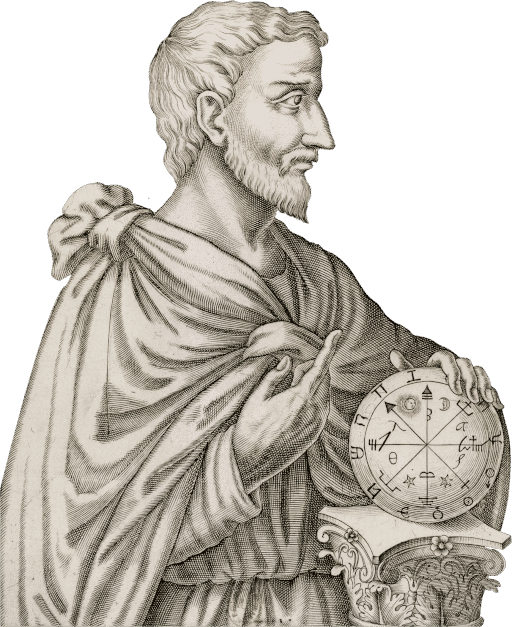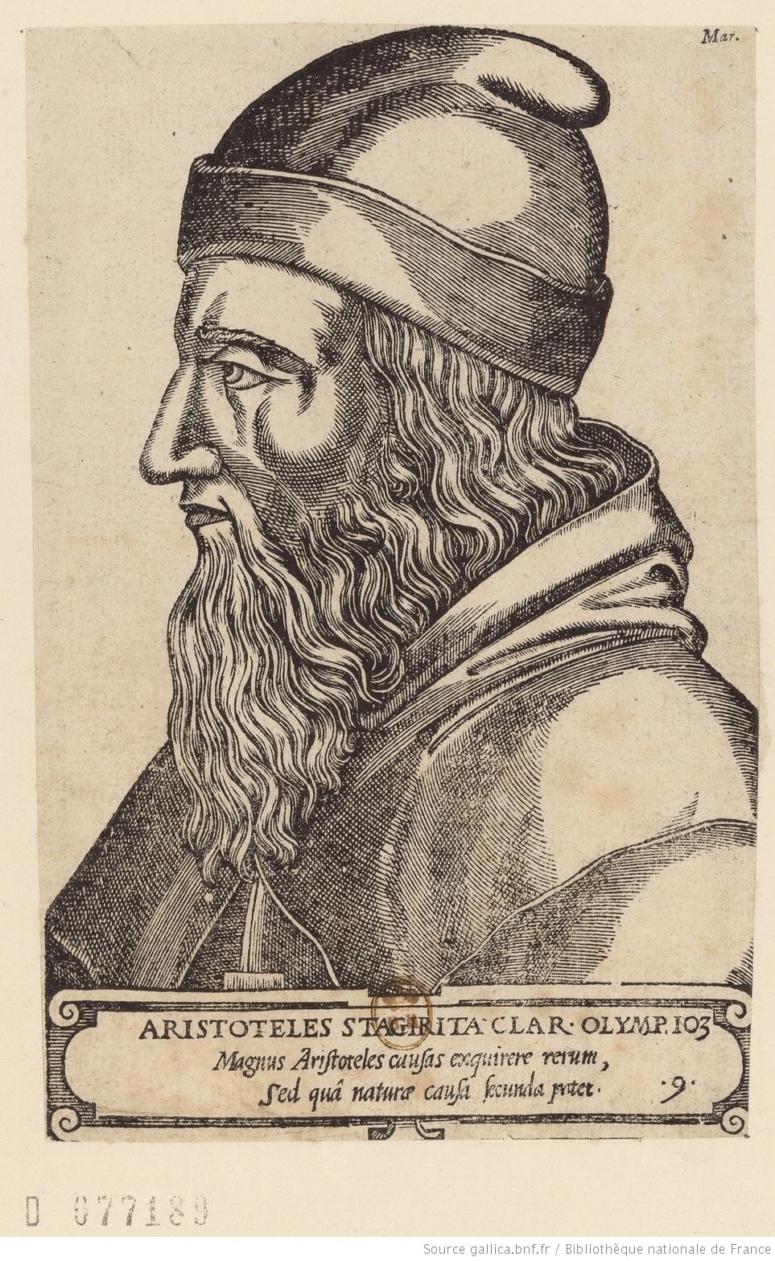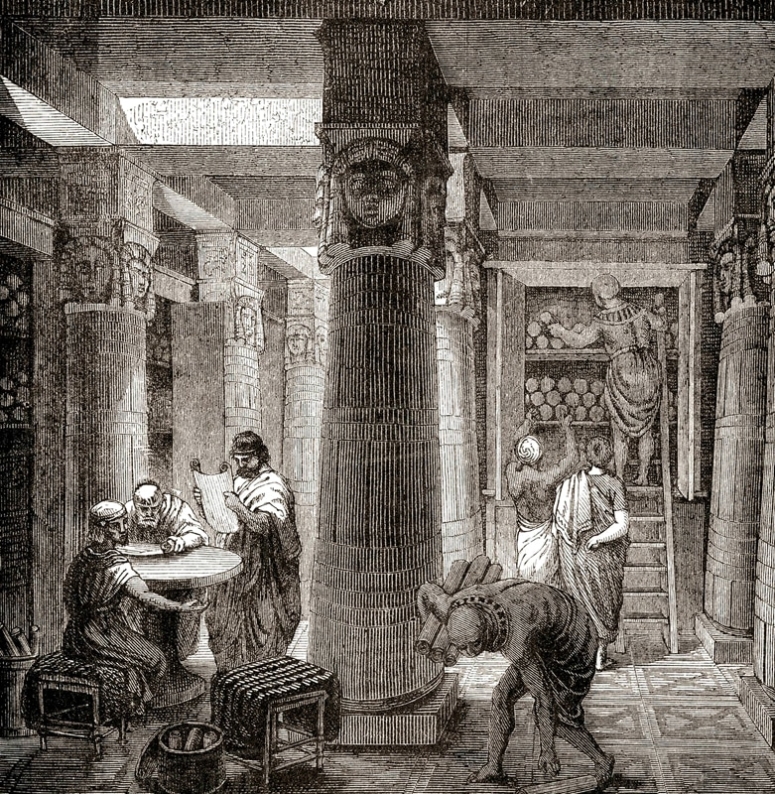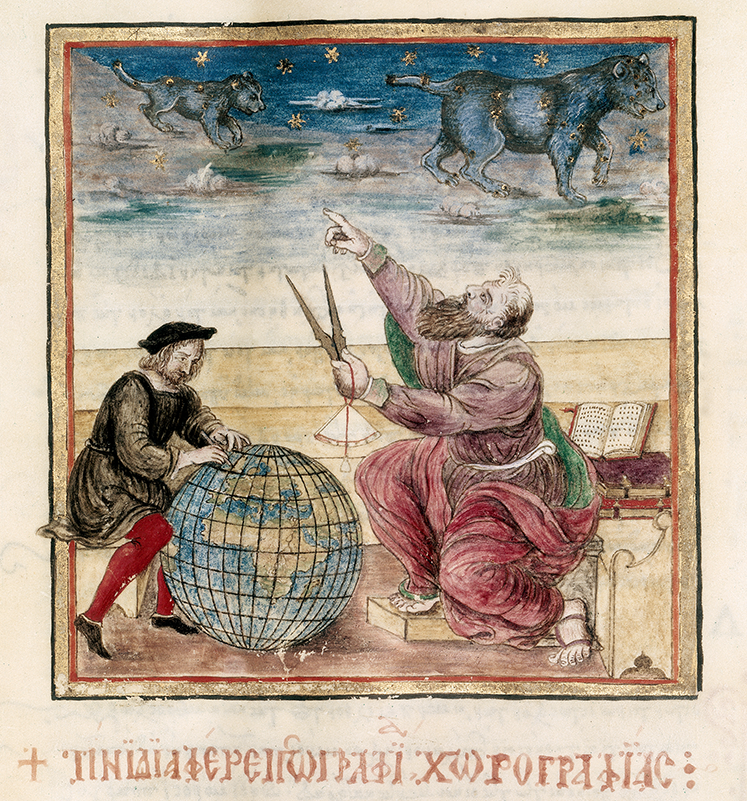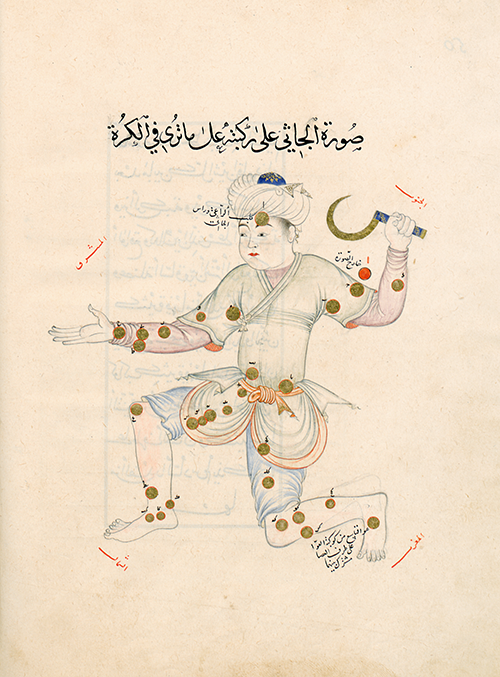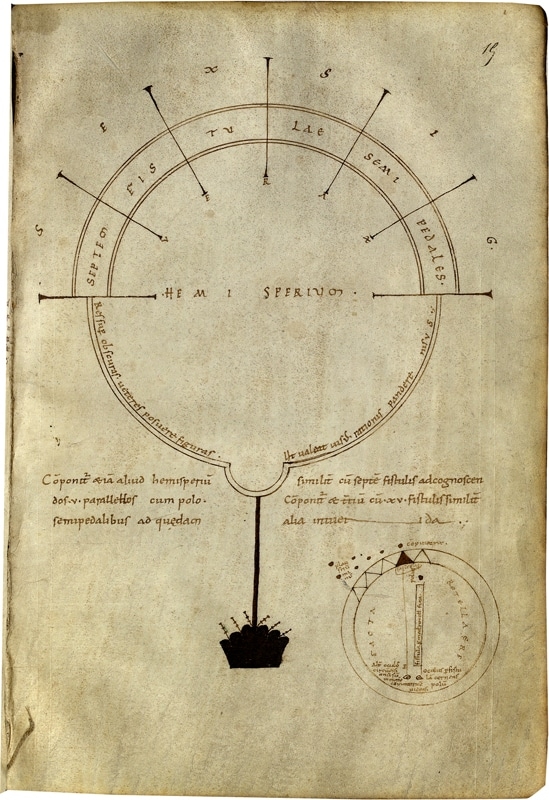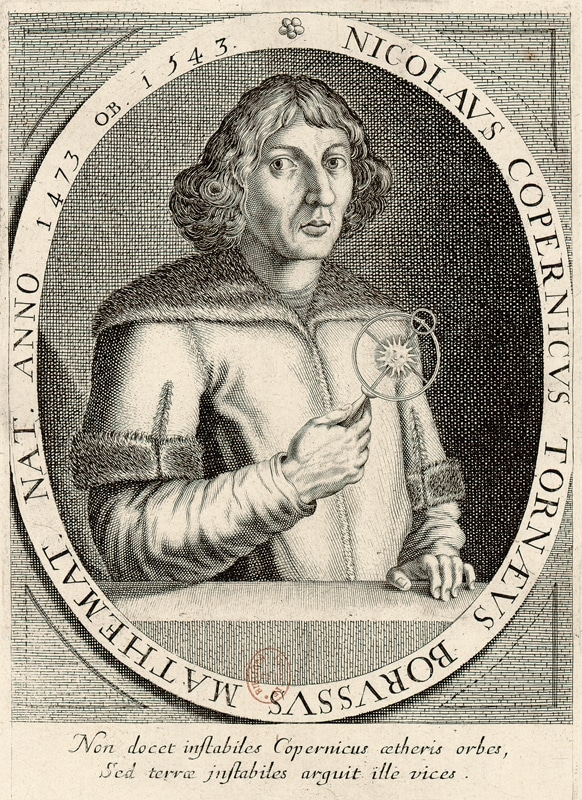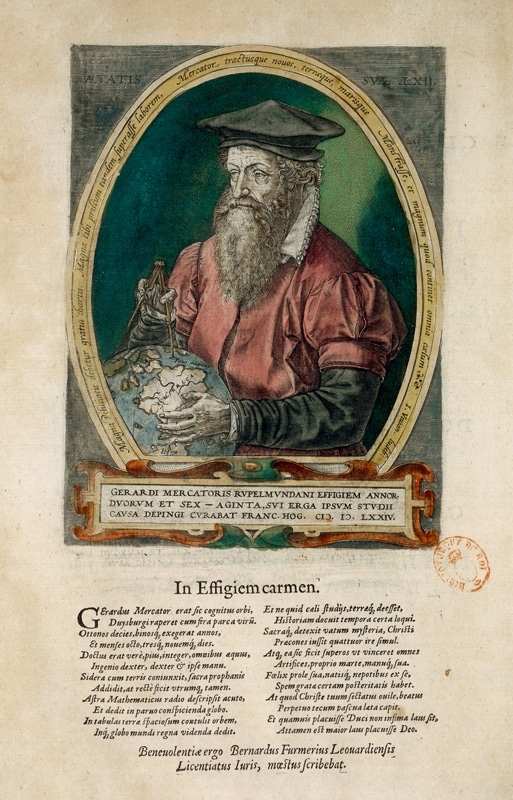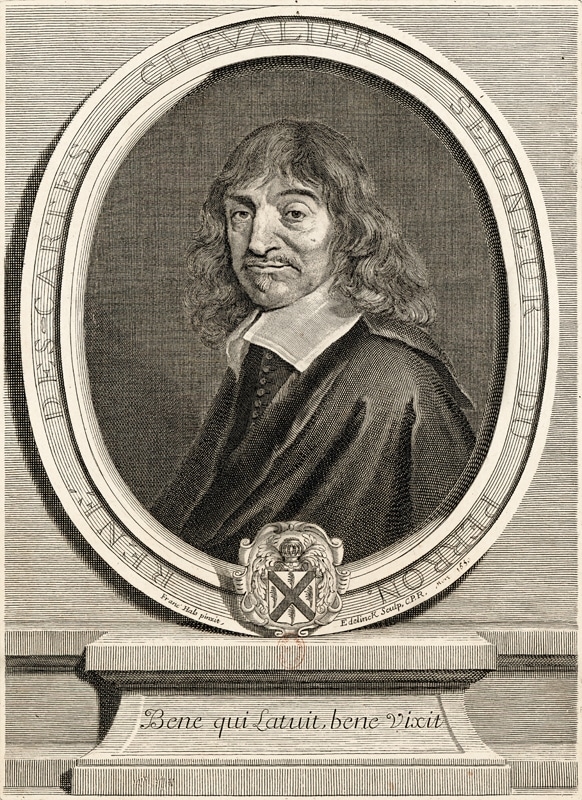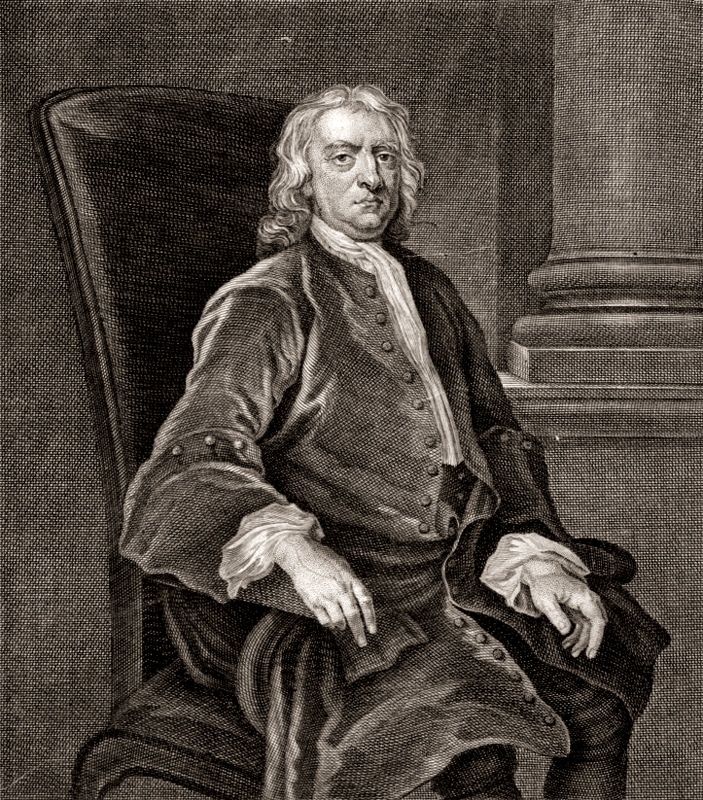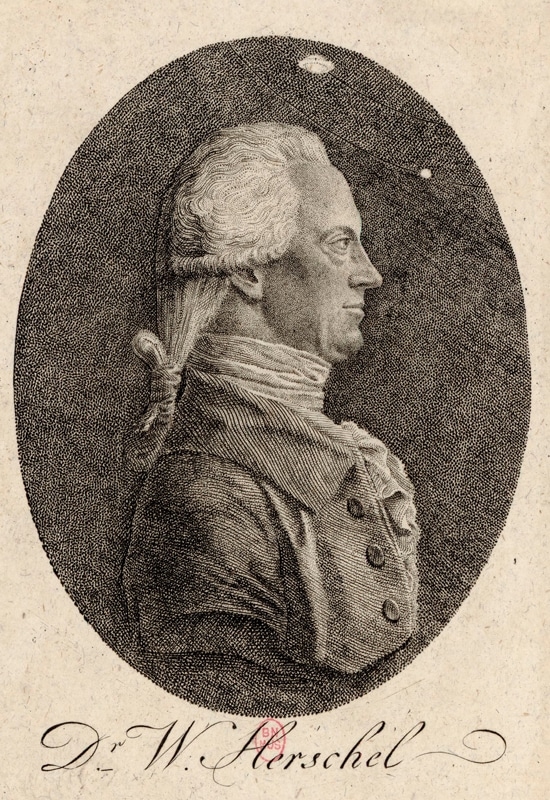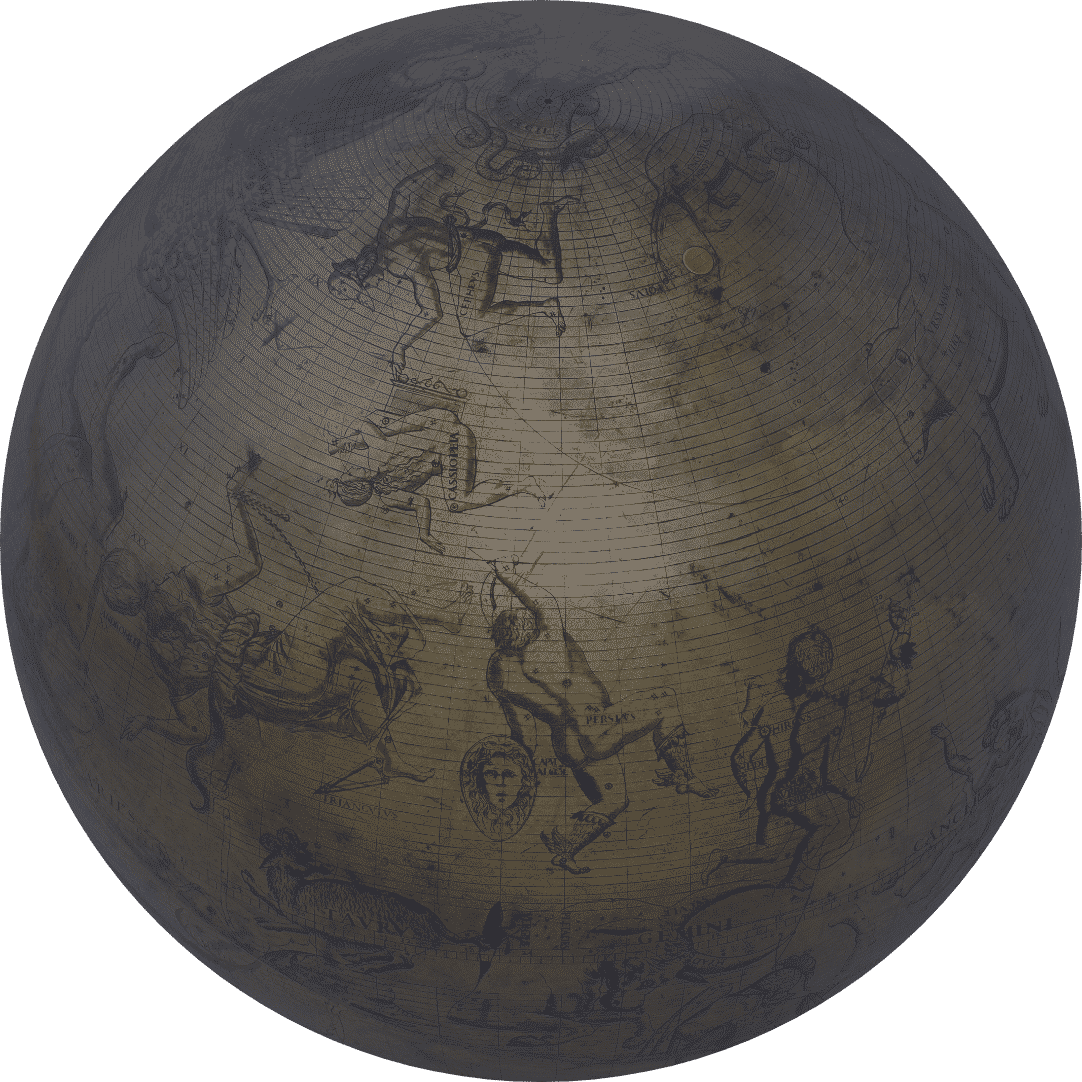
Portraits of Scholars and Scientists
Pythagoras
A pre-Socratic, sixth-century B.C.E. philosopher born in Samos, Pythagoras is a historical personage whose actual life is clouded by legend. It has been said that he traveled for 30 years in order to acquire all of the scientific knowledge of his time – particularly the esoteric doctrines of religious cults – and that he was initiated by Egyptian priests into their secret arcana. The texts that bear his name are doubtless apocryphal. The most precise information about his doctrine can be found in the work of Aristotle, who postulated that the essence of all things was founded on numerical relationships: numbers, the principle behind all things, ruled the universe. Pythagoras and his disciples believed that numbers existed before the sensible world, and that, like geometry and music, cosmology was founded on mathematics. In this way, he intertwined astronomy, mathematics and music. Some Greek authors attributed the discovery of the sphericity of the Earth and the cosmos to Pythagoras. They wrote that Pythagoras was the first to grasp that the morning star and the evening star are one and the same, i.e. the planet Venus. His philosophy, known as “Pythagoreanism” advocated that the goal of life is to be in harmony with the order of the universe.
Plato
Along with Aristotle, Plato (428-348 B.C.E.), is the most renowned philosopher of Ancient Greece. At the school of philosophy he founded in Athens, mathematics and gymnastics were taught as well. Teaching was dispensed in the guise of discussion and debate about ideas, which explains Plato’s penchant for writing dialogues. His best-known work, The Republic, features Socrates, his teacher and one of the first renowned philosophers, debating with several different interlocutors. In it, Socrates develops ideas and arguments about society and the organization of Greek cities, painting the portrait of an Ideal City, a sort of political utopia.
Written circa 360 B.C.E., Timaeus is one of Plato’s last dialogues. Speculating “On the Nature of the Physical World” (as an old, but inauthentic subtitle of the dialogue put it), Timaeus deals largely with cosmology, i.e. the “creation” of the world and its configuration, explained essentially through geometrical figures. It is Plato’s only “physical” dialogue, and despite how difficult it can be to interpret, Timaeus was very popular throughout the Middle Ages, largely because it postulated a Demiurge, or God who created the universe in the shape of a sphere, “the most perfect and uniform shape.”
Although there was strong competition from Aristotelians, Platonism was a fundamental school of thought in western philosophy.
Aristotle
A key Greek philosopher born in the fourth century B.C.E., Aristotle (384-322 B.C.E.) composed a huge body of knowledge on a wide range of subjects (including biology, astronomy and physics), based on observation and experimentation. In 335 B.C.E., this former pupil of Plato’s founded his own school, the Lyceum, in order to teach his philosophy: “Peripateticism” (from the Greek peripatein, “to walk around”). In late Greek Antiquity, Aristotle was considered the great master of scientific studies, as well as of dialectics and argumentation. Later, it was through the intermediary of translations and commentary by Arab philosophers such as Avicenna and Averroes that Aristotle’s work reached western Christianity and influenced Medieval thought. Seen as the father of both logic and metaphysics, Aristotle would be the reference in every field for centuries.
Aristotle expounded on his astronomical theories in his On the Heavens (De Caelo, in Latin). In it, he presents the heavens and the elements that compose “bodies” (any three-dimensional object bounded by surfaces) in a world divided into two parts: the perfect superlunary world, and the imperfect, sublunary one. Aristotle’s heavens, surrounding the Earth in concentric layers, were finite, unique and eternal. “We must show not only that the heaven is one, but also that more than one heaven is impossible, and, further, that, as exempt from decay and generation, the heaven is eternal.” (On the Heavens, Book I, Part 9). Aristotle’s assertion that the Earth was round was based on his observation that boats sank at the horizon as though they were being swallowed up by the sea. He confirmed it through observation and examination of the round shadow that the Earth casts on the moon during lunar eclipses.
Eratosthenes
A third-century B.C.E. Greek astronomer, geographer, philosopher and mathematician, Eratosthenes was appointed director of the Library of Alexandria circa 245 B.C.E. Well informed by the travel narratives he collected for the Library, as well as by his epistolary relationships with scholars, Eratosthenes is one of the founders of geography as a subject. Eratosthenes is famous for being the first person to have estimated the Earth’s circumference. The experiment he performed was preserved for posterity by a later author, Cleomedes (circa the second or third century C.E.) in his De motu circulari corporum caelestium (On the Circular Motions of Celestial Bodies). It was known in Eratosthenes’s time that in southern Egypt, near the city of Syene (modern-day Aswan), there was a well in which the sun’s image was reflected perfectly at precisely noon on the summer solstice. In other words, the Sun was at its zenith over the well, as Syene was near the Tropic of Cancer. Further north, however, in Alexandria, a gnomon (a stake or column standing perpendicular to the horizon) cast a shadow that could be used to determine the Sun’s height. That allowed Eratosthenes to deduce the angular distance between the two cities as 7° 10’. Thanks to bematistae, trained surveyors who measured distances in the desert by counting their steps, Eratosthenes also knew the distance between Alexandria and Syene (approximately 800 km.), so he was able to calculate the value of the Earth’s circumference: 250,000 stadia. This method assumed, as Cleomedes wrote, that Alexandria and Syene were on the same meridian, which is not in fact the case – they are distant by about 19°, which lead to a calculation error of about 5%. But what matters here is not the accuracy of his measurement, but the clever simplicity of his method.
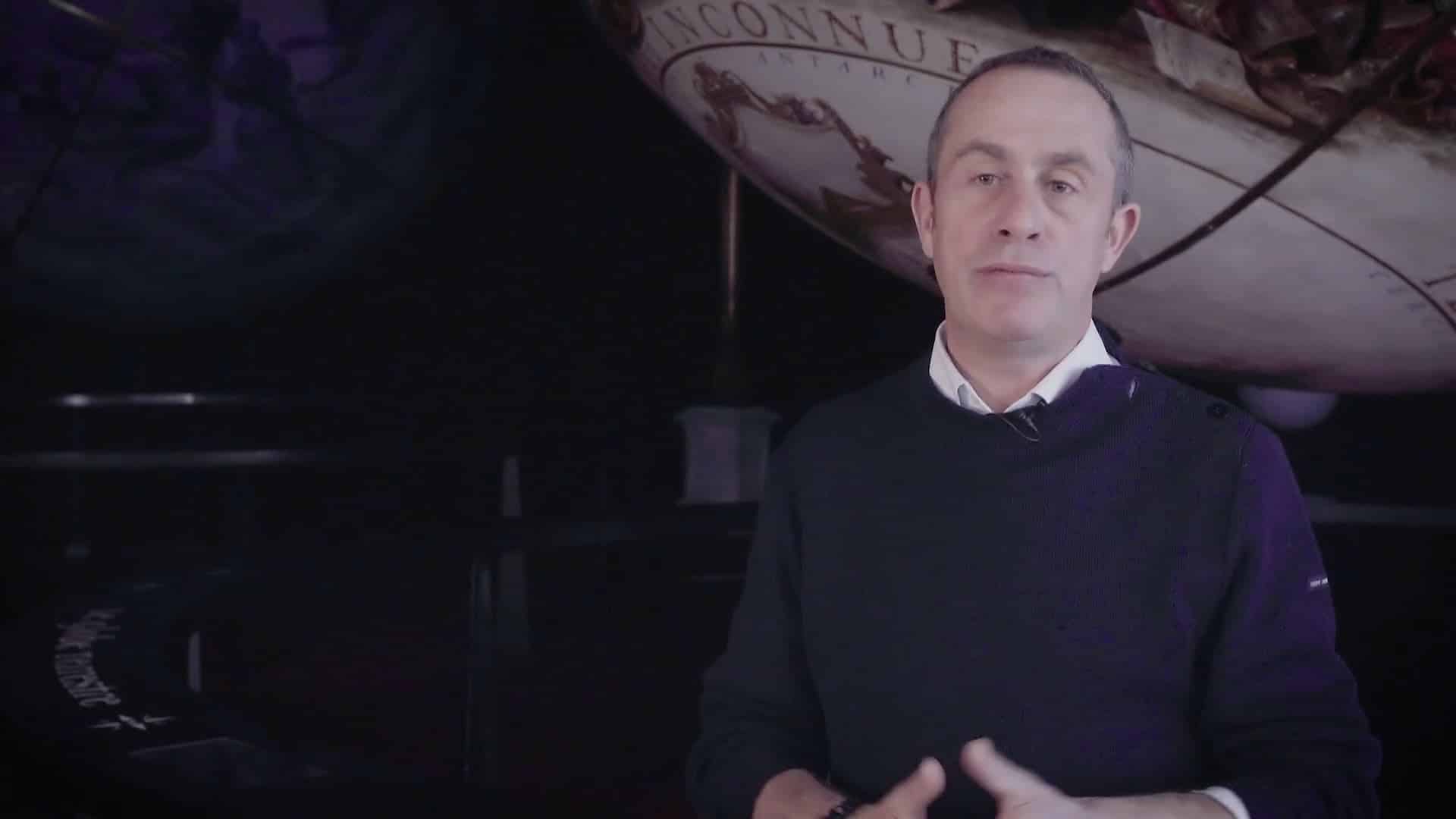
Ptolemy
A Greek scholar who lived in second-century Alexandria, Claudius Ptolemy (100-168) wrote the Almageste and the Geography. The first of these masterful summaries of Greco-Roman knowledge was about the shape of the universe and the motions of the heavens, and the latter about the ecumene, or the known, inhabited part of the Earth. In his treatise on astrology, the Tetrabible, Ptolemy analyzed the supposed influences of the heavenly bodies on individuals’ fates. His body of work represents the apex of Greek astronomy and geography, and contains the foundations of all of our modern knowledge: the idea of a spherical earth, geographic north, the equator and tropics, defining meridians and parallels, calculating geographic coordinates, cartographic projection methods, and maps of the known world.
Ptolemy reconciled the Aristotelian system with astronomical data accumulated over a span of five centuries. The principles of the centrality and immobility of the Earth and the uniform rotation of the heavenly bodies around it, which had been inherited from Plato and Aristotle, obliged early astronomers to compose mathematical models that included an ever-greater number of concentric spheres. This was necessary in order to “save phenomena,” i.e. to justify the seemingly erratic motions of the planets, which were seen as “wandering stars” as opposed to “fixed stars.” The fourth-century B.C.E. astronomer Eudoxus of Cnidus was the first to come up with a 27-sphere model representing the motions of all known celestial bodies. Claudius Ptolemy perfected the model by increasing the number of spheres to 56.
Transmitted successively to the Byzantines, the Arabs, and the Latin west, Ptolemy’s body of work remained scholars’ principal reference for over 1,500 years. In the 12th century, his Almageste was translated from Arabic into Latin by Gerard of Cremona; at the dawn of the 15th century, his Geography was translated from Greek into Latin. The Latin translations revived interest in cosmology, astronomy, and geography in the western world by providing solid theoretical foundations for explorers, cartographers, and astronomers during the 15th-and 16th-century European Age of Exploration.
Al-Sufi
‘Abd al-Rahman al-Sufi (903-986) was a Persian astronomer who lived at the court of the Buyid emir ‘Adud al-Dawla (936-983) in Isfahan. He is the author of three remarkable volumes on astrolabes that solved a number issues in astronomy, but his most important work was The Book of Fixed Stars (Kitāb ṣuwar al-kawākib). In it, he described the 48 constellations from Ptolemy’s Almageste, contributed a great many improvements to the star catalogue (position, magnitude, color), and reconciled the ancient denominations and figurations with indigenous Arab astronomical traditions. In addition, he portrayed each constellation twice: once as it could be seen in the sky, and once as it should be shown on a celestial globe, i.e. in a mirror image. ‘Al-Sufi’s treatise had a tremendous influence, both in the Middle East – where it was copied until the 18the century and provided models for portraying the constellations on celestial globes – and in Europe, where it was translated into Latin in the 12th century.
Gerbert d’Aurillac
Under the name Sylvester II, Gerbert d’Aurillac (938-1003) was elected Pope (999 to 1003) with the support of the Holy Roman Emperor Otto III. He was an important scientist and politician in the western medieval revival that took place around the year 1000. From a humble background, he was admitted at about age 12 to the Benedictine monastery in Aurillac, where he studied liberal arts (trivium and quadrivium). He continued his schooling in the Catalan abbeys of Vic and Ripoll, which were very open to ideas from the Umayyad caliphate in Cordoba. His sharp intellect and breadth of knowledge having attracted attention, in 970, he was called to Rome, where he became the young Otto II’s private tutor. Of all the many positions he held in France and Italy during his long and influential career, perhaps the most fruitful in scientific terms was his role as scholaster at the studium , or cathedral school, at the archbishopric of Reims (972-980). Gerbert is remembered for having contributed to introducing both Indo-Arabic numerals and mathematical-operation tables to the West, as well as reintroducing the abacus. In astronomy he produced several types of celestial spheres for educational purposes. They have since been lost, but we know about them through the descriptions made by his pupil, Richer de Saint-Rémy.
Copernicus
The Polish astronomer and mathematician Nicolaus Copernicus (1473-1543) was the first westerner to introduce the theory of heliocentrism – the idea that the Earth revolved around the Sun, which was believed to be the center of the Universe. What made his De revolutionibus orbium coelestium (On the Revolutions of the Heavenly Spheres), published in 1543, so revolutionary can be summed up in a few postulates: the Earth is not the center of the Universe; all the spheres revolve around the Sun, the center of the Universe; the distance between the Earth and the Sun is extremely small compared to the distance between the Sun and the stars. All celestial motions are produced by the Earth’s own motion and not the firmament’s. The Earth makes one full rotation on its axis a day, and one full revolution around the sun on the ecliptic plane a year.
Heliocentrism was strongly condemned by the Church, because the theory conflicted with the Christian doctrine that stated that the Earth was the center of the Universe. Despite being subjected to censorship, Copernicus’s discoveries triggered a veritable revolution in the way Westerners viewed the world. His work paved the way for Kepler’s and Newton’s.
Mercator
Gerardus Mercator (1512-1594) was a brilliant Dutch geographer and cartographer, perhaps the most notable one from the entire Renaissance period. A mathematician, cartographer, engraver, and globe- and scientific-instrument-maker, as well as a philosopher and theologian at the University of Leuven, he left Flanders for religious reasons. He moved to Duisburg, in the Rhineland, where he was offered a chair in cosmography. Projection systems were a major preoccupation during the Renaissance, and Mercator, republishing Ptolemy, came up with several different possibilities, building a planisphere empirically, through successive approximations. The solution he proposed with his famous world map from 1569 did not catch on right away, but it has been crowned by posterity. Still commonly used in our day, his cartographic method, known as the “Mercator projection,” makes it possible to portray the Earth on a flat surface. His technique consists in projecting the surface of the Earth onto a cylinder that is tangential to the globe at the equator; so the meridians are shown as vertical lines equidistant from each other, and the parallels as horizontal lines. Mercator produced one of the 16th century’s most important pairs of globes, printed from engraved copper plates: a terrestrial globe, in 1541, which included, most notably, the rhumb lines (also known as loxodromes) that were useful for navigation, and a celestial globe in 1551.
Galileo
In just a few nights, Galileo (1564-1642), a mathematics professor at the University of Padua, was thrown into the scientific spotlight when he overturned 2,000 years of Aristotelian astronomy. On November 30, 1609, Galileo pointed a telescope of his own making towards the Moon, and found out that it was, “uneven, rough, full of cavities and prominences.” A short time later, he observed 36 new stars in the Pleiades, and then resolved the Milky Way into thousands of hitherto unseen stars. But his most important discovery will always be the one he made by observing Jupiter, with its four moving moons. Galileo published everything he had learned in a book that made him famous, The Starry Messenger. It explains that the Earth is not the only center for the revolution of stars in the Universe, nor is the Milky Way the exhalation of the atmosphere, or the Moon a perfectly smooth, polished sphere.
In late 1610, Galileo made another major discovery regarding the phases of Venus. His observations clearly proved that they were incompatible with Ptolemy’s geocentric system, which was then still accepted by most astronomers. The phases of Venus, as Galileo had observed them, could only be explained by acknowledging that the planet orbited around the Sun. This was a strong argument in favor of Copernicus’s heliocentric system. Although other astronomers before him had observed sunspots, in his 1613 Letters on Sunspots, Galileo proved that they were in fact on the surface of the Sun, which rotated.
The Holy Office’s 1616 condemnation of heliocentrism and of Copernicus’s De revolutionibus forced Galileo to be more prudent in reference to the Earth’s motion around the Sun. Although he devoted most of his research to physics, Galileo didn’t abandon astronomy, chiming in on a number of controversies, which he often started. After the appearance of three comets in 1618, he stated that those heavenly bodies were not real objects, but atmospheric phenomena.
The 1632 publication of his Dialogue Concerning the Two Chief World Systems, in which Galileo stated in barely veiled terms that the Earth spun on its own axis and turned around the Sun – using ocean tides, in particular, as physical proof – led to the founder of classical mechanics’ eventually being sentenced to permanent house arrest by the Inquisition.
Descartes
In addition to his major contributions to philosophy, René Descartes (1596-1650) obtained important results in mathematics (the development of analytic geometry), optics (discovering the law of sines of refraction) and physiology (discovery of the reflex action). He was also a key figure in the development of 17th-century cosmology.
In his unfinished work, The World, or Treatise on the Light, published posthumously in 1664, Descartes sketched out the core of his vortex theory of planetary motion, which he had laid out in 1644 in his Principles of Philosophy. For Descartes, there could be no vacuum in the universe, but three elements (fire, air, earth) and three sorts of bodies: those that shine, those that are transparent, and those that are opaque.
Descartes’ theory on the genesis of the solar system (called cosmogony), which was the first one, suffered from a lack of knowledge of physical laws, because it was conceived before Newton discovered the law of gravity. In Descartes’s world, where there was no vacuum, vortices ruled, imposing ordering on original chaos by transforming it into a cellular structure of juxtaposed heavens. Like the Sun, each star in the universe was the center of a vortex, or whirlpool, that Descartes called a “sky.” An entire vortex could be destroyed by those around it, in which case the star that was at its center moved to another vortex and turned into a comet.
It is easy to see why Newton would later criticize Descartes’s cosmology harshly, through a mathematical analysis of the dynamic conditions of those vorticial motions: they were not, for example, compatible with Kepler’s laws. What’s more, although Descartes was the first person to clearly state the principle of inertia, his law could not apply in his own world of vortices!
Newton
An English mathematician, physicist, astronomer, philosopher and theologian, Isaac Newton (1643-1727) was the dominant figure of 18th-century science. An advocate of experimental physics, he discovered the law of universal attraction. Unlike the warm welcome he had received in Holland, in France he offended the deeply held beliefs of disciples of Descartes’s physics, which draws only on objects’ “clear and distinct” properties, such as substance and span.
Maupertuis was the first to present a dissertation about Newton to the Academy of Sciences in Paris. Then, in 1738, it was Voltaire’s turn to play an active role in disseminating Newton’s ideas, by publishing The Elements of the Philosophy of Newton. Controversies about the strange force that caused bodies to attract – which Newton demonstrated, but did not explain – proliferated. The fad led numerous amateurs to equip their homes with physics cabinet that allowed them to perform experiments, make observations, and gather data. This fascination for experimental physics, as distinct from the natural sciences to which it had been identified until then, contributed greatly to increasing production and improving the capabilities of scientific instruments.
Herschel
The German-born British astronomer William Herschel (1738-1822) is known for having discovered the planet Uranus, in 1781. Herschel started out in life as an organ-player. Fascinated by astronomy, with the assistance of his sister Caroline, he soon became a significant observer, cataloguing nearly 2,500 nebulae. He used large-diameter telescopes that he built himself, including the gargantuan one he produced in 1789. With a diameter of 48 inches (1.20 meters) for its its primary mirror, and a focal length of 40 feet (12 meters), it was dubbed the “Great Forty-Foot Telescope.” With those instruments, Herschel was able to distinguish luminous clouds and nebulae, which he classified by shape, describing some of them as the “Great Laboratories of the Universe,” somewhat in the manner of the Naturalists. He did, however, realize that not all “fuzzy patches” were necessarily groupings of stars.
Herschel came up with a statistical method of observation for stars based on their brightness. This led him to conclude that the Milky Way was shaped like a flattened ellipse with rough edges. Alas, his hypotheses were false, in that there is no real connection between a star’s distance and its brightness. He also theorized that the Sun was traveling towards an apex located in the Hercules constellation, translating the Earth and its other planets with it.
Herschel true goal was to discover the structure of the Universe based on observation. He published four successive dissertations devoted to cosmology. The title of the first one, published in 1811, could not be more explicit: Astronomical Observations Relating to the Construction of the Heavens. Herschel then tried to discover the structure of the heavens by sounding objects’ distances. In his last dissertation, published when he was 80, his confidence in the power of his telescopes, which he had believed would lead him to the limits of the Universe, was shaken. He concluded that the nature of the heavens is unfathomable.
Herschel was nevertheless the first person to have based certain considerations suitable to the founding of cosmology on observation, rather than on speculation, as Kant did.
